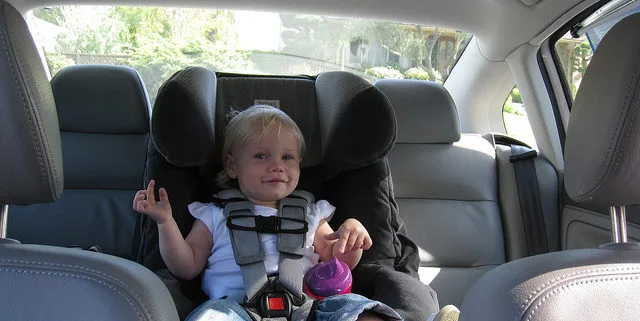California Car Seat Law

California Car Seat Law Basics
In California, children under the age of 8 must ride in a car seat or booster seat in the back – they can’t be in the front seat and they can’t use a regular seat belt. As of January 1, 2017, there’s an additional rule: children under 2 must be in a rear-facing car seat. If the child weighs more than 40 pounds or is more than 40 inches in height, a forward-facing car seat or booster seat is allowed.
Why Are the Rules Different for Children?
Like all seat belt laws, California car seat laws are a matter of safety. The issue is that regular seat belts are designed to fit adult bodies; children that are too small actually run the risk of serious injury to the neck if they’re involved in a wreck and are wearing a regular seat belt. For one, the shoulder strap of the seat belt is just too high up and can pull on your child’s neck. For two, infants and small children have weaker neck and back muscles than adults (and comparatively larger heads) and they need more support to protect them in case of a crash. That’s why car seats have serious neck support and use a multi-point harness rather than the standard one-point seat belt that adults use.
Keeping Your Children Safe in the Car
The reason we use car seats and booster seats isn’t just because the law requires it; it’s because that’s the best way to keep our children safe on the road. And simply having a car seat isn’t enough. Car seats aren’t going to help protect your little one unless you’re using it correctly – and that’s harder than you think. Experts say that 85% of us aren’t properly securing our children in the car.
So what does it take to safely secure a child?
The first step is to find the right car seat. Children up to 2 years old need a rear-facing car seat; that’s the safest configuration for your little one’s head and neck in case of a crash. As children grow, the rear-facing car seat won’t offer enough room. Your car seat will have a height and weight limit, so it’s time to upgrade to a larger or front-facing seat when your child meets that limit. You can legally switch to a front-facing car seat at 2 years old, but it’s safer to use the rear-facing car seat for as long as your little fits comfortably. You can find car seats that are exclusively rear-facing as well as seats that convert from rear-facing to forward-facing.
For a child that has outgrown the height and weight limits of a forward-facing car seat, it’s time to move on to a booster seat. Where a car seat cradles the baby to protect the head and neck, a booster seat just puts your child in a position where the regular seat belt fits properly. You can legally stop using the booster seat once your little one hits 8 years old, but it’s always safer to stick with the booster seat until your child outgrows it and is big enough that the seat belt fits properly without it.
Whether you’re buying a car seat or a booster seat, make sure to check out reviews online to get a sense of how safe they are and how easy they are to install.
Once you’ve chosen the right car seat, the next step is to properly secure it. This is the part that trips people up the most – it’s surprisingly hard to do it right. In cars made before 2002, you’ll need to secure the car seat using the seat belt. Pull it as tight as you possibly can; you shouldn’t be able to move the seat more than an inch in either direction. Cars made after 2002 have LATCH (lower anchors and tethers for children) systems designed specifically for car seats. Make sure you use the system as intended (including the upper tethers) to make sure the car seat doesn’t move in case of a crash.
Whether your car has LATCH or not, the car seat should be tightly fastened to the car. In addition, the seat belt or tethers should be completely flat; twisting them can mean your child gets thrown around more in a crash. Before you buy a car seat, go to the store and test it out – make sure it fits properly in your car and that you can secure it tightly.
In general, it’s safest to put the car seat in the middle. However, it’s generally considered better to put the car seat on the side if your car has a LATCH system on the side but not in the center.
Moving to the Front Seat
There’s a reason safety experts recommend keeping your kids in the back seat: airbags. It’s a similar concern to seat belts. As adults, air bags protect our faces and necks. Children are too short and an airbag can actually cause more harm than good. That means your child should sit in the back seat until they’re at least tall enough to properly fit an adult seat belt – usually around 4’9″ or 4’10”.
You should never put a car seat in the front seat – the air bag can knock the car seat out of position and hurt your child.
Stay Safe on the Roads!
California is notorious for its traffic and there are plenty of accidents every day. Using a car seat correctly will keep you in line with the law but more importantly, it’s a really important part of keeping your child safe on the roads.
Image Credit and License
Are you in search for a certified attorney to represent you?
Let us help you find one today!




Can a baby be remove from the car seat if that child need to be breastfed while driving?
I could not see anything in black and white.
Gonzales,
No. All passengers must be safely secured by the proper safety belt, car seat, or booster seat depending on their age and size. At all times.